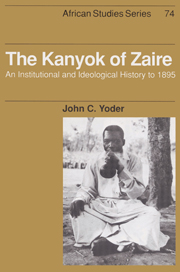Book contents
- Frontmatter
- Contents
- List of maps and figures
- Acknowledgments
- Abbreviations
- Chronology
- Introduction
- 1 Wood and wine, gardens and game
- 2 Stratification, symbols, and spirits
- 3 New legends for new leaders
- 4 Serpents and lightning
- 5 Dances, moats, and myths
- 6 Combat, classes, titles, and trade
- 7 Schisms and slaves, ghosts and guns
- 8 Assassinations, alliances, and ambushes
- APPENDIX: Methodology
- Notes
- Bibliography
- Index
- Titles in the series
6 - Combat, classes, titles, and trade
Elements of Kanyok society in the nineteenth century
Published online by Cambridge University Press: 29 September 2009
- Frontmatter
- Contents
- List of maps and figures
- Acknowledgments
- Abbreviations
- Chronology
- Introduction
- 1 Wood and wine, gardens and game
- 2 Stratification, symbols, and spirits
- 3 New legends for new leaders
- 4 Serpents and lightning
- 5 Dances, moats, and myths
- 6 Combat, classes, titles, and trade
- 7 Schisms and slaves, ghosts and guns
- 8 Assassinations, alliances, and ambushes
- APPENDIX: Methodology
- Notes
- Bibliography
- Index
- Titles in the series
Summary
Nineteenth-century Kanyok society was a composite of ideas and institutions drawn from the common ancient Bantu heritage and of practices and concepts developed, shared, or borrowed in more recent periods of interchange with savanna neighbors. In the seventeenth and eighteenth centuries, wars and raids, migrations and intermarriages, expeditions for trade or political office, Luba imperial expansion, growing Lunda cultural prestige, and the rise of the Luso African commercial system, all played a role in facilitating the exchange and development of military, social, political, and commercial institutions upon which Kanyok society was built. Understandably, Kanyok society shared many traits with the cultures of neighboring peoples – both near and distant – who fought, governed, and traded across the southern savanna.
Military structures and strategies
The challenge of Luba invaders in the decades around 1800 encouraged a reorganization and strengthening of the Kanyok army under Ilung a Cibang. Although his military importance has been exaggerated by oral historians, although developments which took place under other leaders were attributed to him, and although offices and strategies borrowed from neighboring peoples were ascribed to his genius, the Kanyok military at the end of his life was more powerful and highly structured than when he took office as Mwen a But soon after 1800.
Biin Luhit
In the nineteenth century, the Kanyok fighting force was organized into three basic divisions known as the Biin Luhit, Biin Mazemb, and Biin Mund. The Biin Luhit (men of war) were a group of professional soldier-police led by the Mwen a Mwilomb and his adjunct, the Mwadi a Mvit.
- Type
- Chapter
- Information
- The Kanyok of ZaireAn Institutional and Ideological History to 1895, pp. 81 - 110Publisher: Cambridge University PressPrint publication year: 1992



